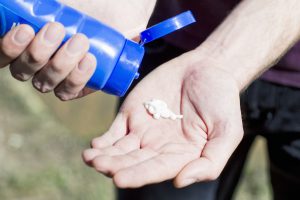The Truth About Sunscreen: 7 Facts That Will Set You Straight for Skin Protection This Summer
Posted on byBy Anne K. Julian, Ph.D.
Behavioral Scientist, Division of Cancer Prevention and Control
With summer around the corner, smart sun-lovers are planning how to keep their skin safe from sunburn and skin cancer while enjoying the warmer weather. Here are some important facts about sunscreen that will have you loving your skin and the summer at the same time!

Sunscreen is protective. Sunscreen protects your skin from the sun’s rays when used as directed. However, some research suggests that sunscreen users get burned frequently, which may be because they use too little, apply or reapply it too late, or use it to engage in otherwise unsafe sun exposure like staying out longer or not wearing protective clothing.
You have to use a lot. That means a shot glass full to cover the full body, and a fourth to a half teaspoon for the face. Studies have shown that consumers use much less sunscreen than is needed to be effective, so use more than you think you need, or get a measuring spoon!
Use a combination of sun safety approaches. Sunscreen isn’t an all-protective force field. It is intended to be combined with other sun-safety approaches, like covering up with clothing, staying in the shade, wearing a hat, and scheduling activities to avoid times of day when the sun is most intense (10 a.m. to 4 p.m.).

It doesn’t have to be greasy. Recent advances in sunscreen technology have led to improved textures and consistencies of sunscreens, from sticks for those who like to roll it on, to light milks that spread easily and leave no white cast. The days of thick pastes are over, but you still need to apply a lot, so pick a product with a texture you really like!
It isn’t just a girl thing. Few men look forward to having wrinkles, age spots, or discolored skin. Sunscreen isn’t just a product for women; using sunscreen and other sun-safety strategies is critical for anyone looking to prevent the premature aging that comes with sun exposure—not to mention helping prevent skin cancer.
Coconut oil is not a good sunscreen. Although some sunscreens contain coconut oil, the oil itself is not adequate to prevent skin damage. Coconut oil may extend the time to burn for some people, but the level of UV protection is very low and may be highly variable by source, so don’t rely on coconut oil to protect your skin!
Sunscreen is not a “do-it-yourself” kind of product. Sunscreen is a non-prescription drug intended to protect the skin. You wouldn’t strap your child in using a seatbelt you made at home, so why protect their skin with untested homemade sunscreen? If you’re concerned about the safety of ingredients in sunscreen, there are other options. You can move your outdoor activities to morning or evening, when the sun is less intense, and cover up, wear a hat, stay in the shade, and use a store-bought, mineral-based sunscreen.
20 comments on “The Truth About Sunscreen: 7 Facts That Will Set You Straight for Skin Protection This Summer”
Comments listed below are posted by individuals not associated with CDC, unless otherwise stated. These comments do not represent the official views of CDC, and CDC does not guarantee that any information posted by individuals on this site is correct, and disclaims any liability for any loss or damage resulting from reliance on any such information. Read more about our comment policy ».


Thanks for the sunsafe advice. I’d also appreciate help in understanding and choosing among SPF ratings, as well as reapplication info.
Great questions! SPF stands for sun protection factor. The SPF value indicates the level of sunburn protection provided by the sunscreen product. Higher SPF values (up to 50) provide greater sunburn protection. To get the most out of your sunscreen, choose one with an SPF of at least 15. If your skin is fair, you may want a higher SPF of 30 or 50. Apply sunscreen at least 15 minutes before you go outside. Reapply it at least every two hours, and more often if you are sweating or getting in and out of the water.
I’m allergic to the chemicals used in many sunscreens, so have to use the barrier sun screens (metals). Can you talk more about those?
Sunscreen active ingredients can be divided into two categories: chemical and mineral. Chemical sunscreens absorb the sun’s UV rays. Mineral (barrier) sunscreens reflect UV rays away from your body. Both types of sunscreen are effective at protecting skin from sun damage.
Zinc oxide and titanium dioxide are the two mineral sunscreen ingredients you will find in stores in the U.S. If mineral sunscreens work best for your skin, look for a sunscreen with either zinc oxide, titanium dioxide, or both listed as the active ingredients. Be sure to select a sunscreen with an SPF of at least 15 that is also labeled “broad spectrum.”
Is sunscreen harmful to the environment (water? Are the chemical in sunscreen toxic, what about zinc based?
Thank you.
Some research suggests that oxybenzone, an active ingredient in many sunscreens, may possibly harm coral reefs. The effects of mineral sunscreen ingredients like zinc oxide are still being studied. However, there are many other sun protection options beyond sunscreen that can be used when spending time in and around the water. Long sleeved swim shirts, wide brimmed hats, and shade can help to protect skin from sun damage. And outdoor activities can be scheduled so as to avoid midday, when the sun is most intense, which will also help to reduce sun exposure.
I have heard that there are ingredients in certain sunscreens that are better to avoid. Can you tell me if that’s true? And, if so, what ingredients are those? And, on the flip side, are there ingredients to look for that are most effective and safe?
The US Food and Drug Administration (FDA) regulates sunscreens to ensure they are safe and effective. FDA recently issued a proposed rule that describes proposed requirements for sunscreens. More information about this proposed rule and which ingredients to look for in your sunscreen, is available at https://www.fda.gov/drugs/understanding-over-counter-medicines/sunscreen-how-help-protect-your-skin-sun.
“results, published in the journal JAMA, show that contrary to what sunscreen manufacturers have been saying, UV-blocking chemicals do seep into circulation. Then, like other over-the-counter drugs the Food and Drug Administration oversees, sunscreens should be studied to make sure they don’t mess up people’s hormones, affect their reproductive systems, or cause cancer. Such safety testing has never been done on the active ingredients in sunscreen, because those chemicals were approved decades ago, before anyone suspected they could be absorbed into the body.” https://www.wired.com/story/sunscreen-chemicals-soak-all-the-way-into-your-bloodstream/ – Megan Molteni. 05.06.19.
Do sunscreens still contain PABA?
Thank you for your question. Many PABA-free sunscreen products are currently available, some of which specifically have a “PABA-free” label.
I live in a northern climate, Rochester, NY. Does sunscreen need to be worn every day even when the sun’s rays are not very strong?
Thank you for your question. According to the World Health Organization, sun protection is needed when the UV Index is 3 or higher. The UV Index is often provided in local weather forecasts and is also available on the United States Environmental Protection Agency website at https://www.epa.gov/sunsafety/uv-index-1.
Many sunscreens claim to have anti-aging properties, are they still safe for everyday use? I know some anti-aging ingredients (like retinol, for instance) may make your wrinkles look worse once you stop using them. Does it apply to sunscreens too and should such sunscreens be avoided? Particularly, I was considering buying the one from SkinMedica. Thank you.
Very happy to read great useful information
Will a sunscreen with a high SPF keep you from getting a tan?
Sunscreen is designed to protect your skin from sun damage that can cause sunburn and increase skin cancer risk. A suntan, like sunburn, is a sign of sun damage. If properly applied, broad spectrum sunscreen would likely reduce the amount a person’s skin darkens or tans following sun exposure. And in general, a sunscreen with a higher SPF provides more protection.
What is the best sunscreen to use?
I have heard that anything over SPF 30 is a sham. Is that true?
While it is generally recommended to use SPF 30 for indoor activities and SPF 50 or higher for outdoor activities, do we need to account for the specific location and weather conditions when selecting the appropriate sunscreen SPF level? Or is it sufficient to carry both SPF 30 and 50 sunscreens in one’s bag?